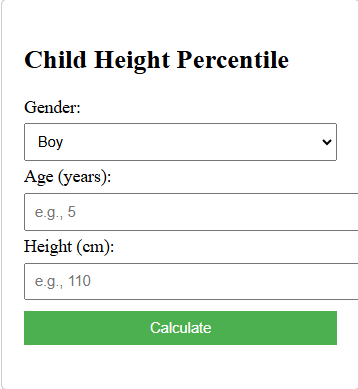Child Height Percentile
📏 What Is a Child Height Percentile Calculator?
A Child Height Percentile Calculator helps parents understand how their child’s height compares with children of the same age and gender. It uses percentile growth charts (CDC for ages 2–20; WHO for under 2) to show whether your child is below average, average, or above average for growth healthyheights.com+2inchcalculator.com+2omnicalculator.com+2omnicalculator.com+1infantchart.com+1.

🧠 Why Height Percentiles Matter
Percentiles:
- 📊 Show how your child grows compared to peers.
- 🚨 Help identify growth issues if the child crosses more than two percentile lines.
- 🩺 Are used by pediatricians along with weight and BMI to assess health. en.org+1inchcalculator.com+1.
🔍 How to Use It
- Enter your child’s age in years & months.
- Choose gender (boy/girl).
- Enter height in cm or inches.
- Click Calculate to get the percentile.
The result: their percentile (e.g. 75th), meaning the child is taller than 75% of peers.
📈 How Percentile Works (Visual)
mermaidCopyEditbar
title Child Height Percentiles
"5th Percentile": 5
"25th Percentile": 25
"50th Percentile": 50
"75th Percentile": 75
"95th Percentile": 95
The visual helps parents see where their child falls in the typical growth range.
🗓️ Interpreting Percentiles
- Below the 3rd percentile: May indicate short stature or slow growth.
- Between 3rd–97th: Considered normal for most healthy children.
- Above 97th percentile: May indicate tall stature.
- Track consistency—children who follow their percentile curve are most likely growing in a healthy pattern omnicalculator.com+1infantchart.com+1inchcalculator.comverywellfamily.com+1parents.com+1inchcalculator.com+2reference.medscape.com+2cdc.gov+2.
🔗 Related Internal Tools
- Child BMI Percentile Calculator
- Child Weight Percentile Calculator (if exists)
- All-in-One Growth Tools
🌐 Trusted External References
- CDC – Growth Charts & Percentiles en.wikipedia.org+13cdc.gov+13en.wikipedia.org+13verywellfamily.com+4cdc.gov+4cdc.gov+4calculator.net+9cdc.gov+9infantchart.com+9
- Nemours KidsHealth – How to Use Growth Charts kidshealth.org+1parents.com+1
- Healthy Heights – Understanding Height Percentiles healthyheights.com+1omnicalculator.com+1
These resources provide official charts and explain how percentiles are used clinically.
🎯 Practical Use & Insights
- 🧭 Growth tracking—monitor percentile shifts over time.
- 👪 Familial context—percentile expectations should consider parents’ heights verywellhealth.com+15healthyheights.com+15verywellfamily.com+15parents.com+2peditools.org+2en. Wikipedia.org+2.
- 🩺 Consult a doctor if your child’s percentile crosses more than two major lines or enters the <3rd or >97th range.
- 📅 Children grow faster in first 2 years (use WHO charts) then switch to CDC charts for ages 2–20 reference.medscape.com+2inchcalculator.com+2omnicalculator.com+2cdc.gov+4infantchart.com+4inchcalculator.com+4.
💡 Tips for Parents
- Measure height without shoes, standing straight.
- Track periodically (e.g., every 3–6 months).
- Use average measurements across multiple visits for accuracy.
- Discuss patterns with pediatricians—they focus more on trends than single readings calculator.net+2verywellfamily.com+2infantchart.com+2omnicalculator.com.